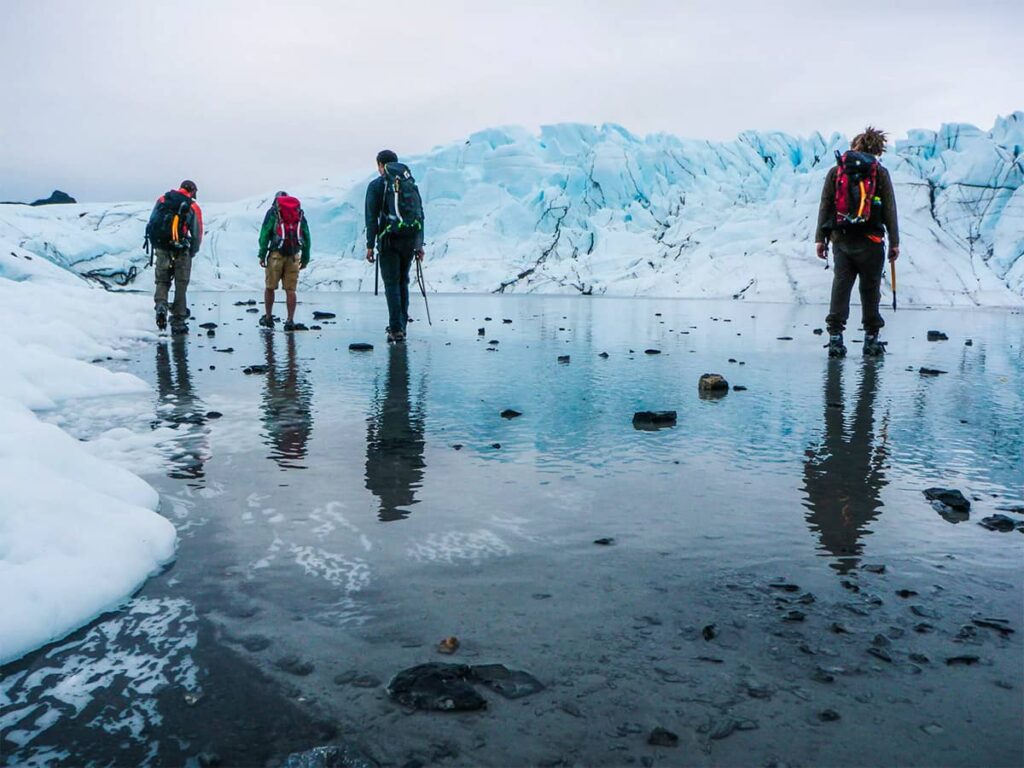Matanuska Glacier Tours Sights and Sounds
Freeze Up: The Transition from Summer to Winter on the Matanuska Glacier
Article updated October 30, 2023 originally published: November 04, 2020
Matanuska Glacier Summer to Winter Transitions
One of the most common questions asked of our guides is whether they prefer summer or winter on the glacier. The answer is not so simple; it’s like comparing night and day. While there are some who have a preference, the truth is there is no comparison. Instead of having glacier summer and glacier winter square off in an ultimate Battle Royale, we want to dissect the differences and view this seasonal transition as a delicate dance of Mother Nature’s elements.

Summer on the Matanuska Glacier
In the summer, all the beautiful elements of the glacier (metamorphic rocks, silt, crevasses, moulins, conduits, and a multitude of other features) are clearly visible as you walk the trail. We access the left side of the glacier, trekking down the moraine, and then hit the hard white ice towards the face. As you walk, it is easy to spot treacherous areas and avoid them. These features are obvious, which is why we open our self-guided trail and allow visitors to access the glacier at their leisure so they can enjoy the majestic beauty of the ice and the serene landscape that surrounds it.
The Transition
Once the water starts to freeze and the snow begins to fall, one side of the glacier (the left side we’ve been accessing all summer) slowly begins to “turn off” and the right side of the glacier begins to “turn on.” The beautiful elements of summer become covered with snow; large boulders, sharp rocks, crevasses, and moulins are no longer visible to the naked eye. A leisurely stroll has now become a glacial exploration, one in which you are only advised to travel with an experienced guide. It is much more technical than anyone can imagine because of all the hidden elements, not to mention thin ice, which only becomes solid around mid-November.
Winter on the Glacier
After weeks of below freezing temperatures and testing the thickness of the ice, we begin our long winter season on the Matanuska. The right side of the glacier “turns on” and our guides begin exploring crevasses and embark on the never-ending feat of finding ice caves. The contrast of the blue ice against the fluffy white snow is breathtaking. Albeit cold, people come from near and far to view what is truly a winter wonderland. At this point in the season, there is no more melting and the glacier is advancing forward (approximately 80 meters of forward movement every winter). Pressure ridges form on the river ice, a process that happens because of the glacier putting pressure on the frozen water. These pressure ridges can “grow” up to 15 feet and look like frozen waves suspended in an otherwise flat ice rink of the Matanuska River. We trudge through the snow, around the frozen waves of ice, into magnificent blue crevasses as tall as 30-story buildings. We crawl into black ice caves adorned with hoar frost crystals, compete in “penguin slide” competitions, and admire the frozen beauty that surrounds us. Everything is quiet, and we are alone in winter’s solitude.
Two Separate Places
When it comes down to it, there is no comparison between summer and winter on the glacier. It’s as if we’re talking about two separate places. This is why we encourage people to visit in both seasons. It will never be a chore because “I’ve been there before.” It’s a completely different experience. We will let you decide for yourself which one you like better, but we assure you, it’s hard to pick because each offers its own unique wonder, beauty, and adventure.

